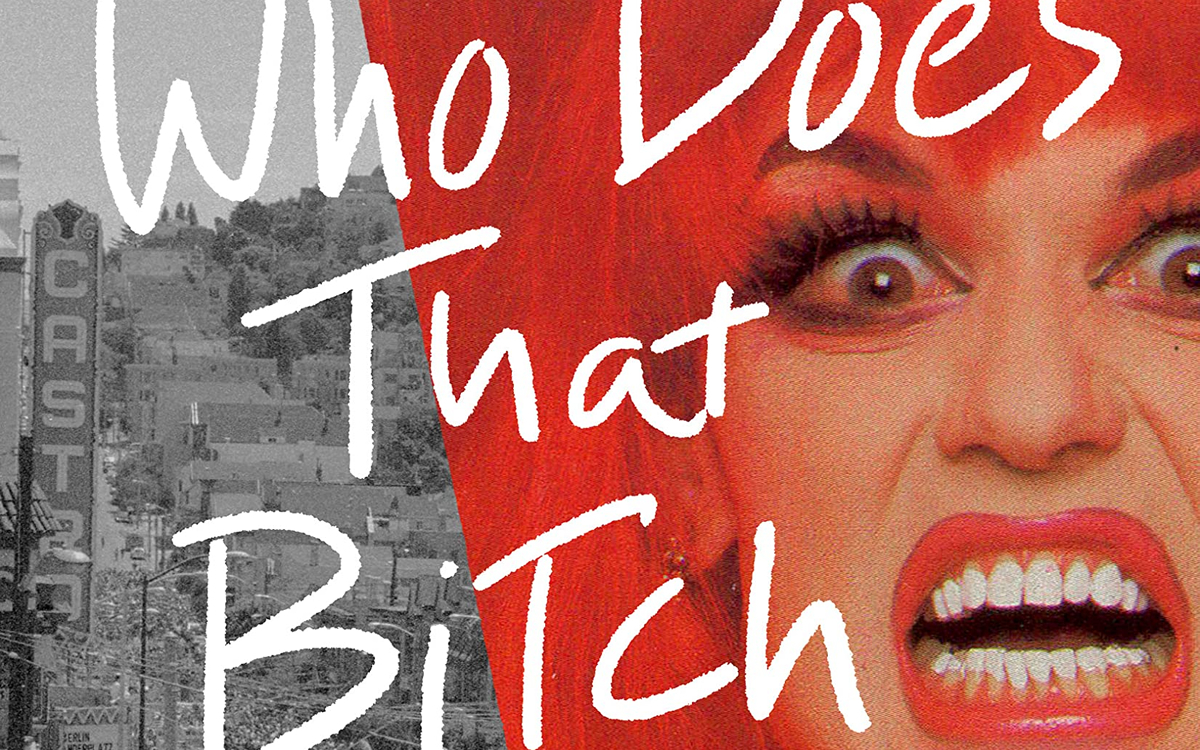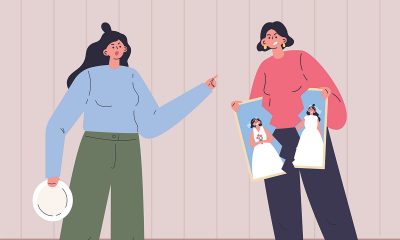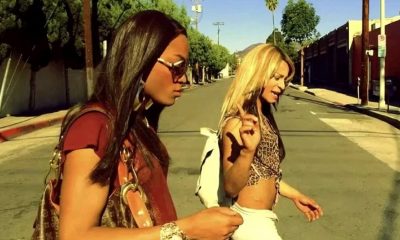Books
A timely biography of drag queen Doris Fish
An eye-opener to queer life in Sydney and San Francisco

‘Who Does That Bitch Think She Is? Doris Fish and the Rise of Drag’
By Craig Seligman
c.2023, PublicAffairs
$29/352 pages
Tennessee, home of Dollywood, just passed legislation banning “adult-oriented performances that are harmful to minors.”
“If I hadn’t been a girl, I’d have been a drag queen,” Dolly Parton has said. (Make of that what you will, Tennessee Gov. Bill Lee.)
Nothing is more timely than cultural critic and writer Craig Seligman’s new work of queer history “Who Does That Bitch Think She Is? Doris Fish and the Rise of Drag.”

One day in the 1980s, Doris Fish, a San Francisco drag queen, sat for a shoot in a beauty salon. Sitting under a dryer, “curlers in his yellow fright wig, wearing a fuchsia top, turquoise pedal pushers, white peep-toe pumps and (too much) matching makeup, wide-eyed in what looks like despair,” Fish modeled for West Graphics, a local greeting card company, Seligman writes.
These greeting cards featured queer humor. “BOTH YOUR DOCTOR & HAIRDRESSER AGREE! THIS TIME IT’S GOING TO TAKE MORE THAN A COMB-OUT,” the caption to the card with Fish’s stunning beauty parlor photo, read.
Then, most gay people weren’t proud or irritated by these greeting cards, reports Seligman in his captivating history of drag told through the life of Fish, who was legendary in San Francisco from the 1970s until he died from AIDS in 1991.
The greeting cards were just funny to queer people at that moment, Seligman writes, “which was how the rest of the country saw them, too.”
“Yet it’s hard to envision their taking off the way they did a decade earlier,” he adds, “The very people who might once have been appalled to learn they had a queer family member were snapping up these artifacts of gay humor.”
This is one of the many insights into cultural changes in attitudes toward queer people and drag to be found in Seligman’s illuminating bio of Fish.
Fish was born into a middle-class, Catholic family in 1952 as Philip Clargo Mills in Manly Vale, a suburb of Sydney, Australia. (Even the most ironic novelist wouldn’t have come up with that name!)
Doris considered himself to be what we, today, would call cisgender, Seligman reports.
Fish’s Australian friends and family referred to Fish as “he” and “him,” Seligman writes. When Fish’s queer male friends called him “she,” it was “Mary camp banter,” not “gender confusion,” he adds. For these reasons, Seligman refers to Fish with masculine pronouns.
After a childhood spent quietly drawing, Fish became a star of the Sydney drag queen scene. He performed with, what Seligman calls a “psyche troupe” of drag queens, Sylvia and the Synthetics.
After moving to San Francisco in the 1970s, Fish performed in the beloved drag shows “Sluts a Go-Go” and “Nightclub of the Living Dead” as well as the outrageous sci-fi drag film “Vegas in Space.”
Fish, Seligman makes clear, was complex, talented, and creative. Along with being a drag queen, he was a sex worker and artist. Fish was disciplined in all these areas of his life, Seligman writes.
“All three of those personas centered on his gayness,” Seligman adds, “at a time when homosexuality was just beginning to make its way toward the center of the conversation in both of the countries [Australia and the U.S.] he called home.”
Fish’s life and work were entwined with queer history – from Club 181 to Anita Bryant’s vicious anti-queer “Save Our Children Campaign” to the heroic role that Dianne Feinstein (as mayor of San Francisco) played during the AIDS crisis. Many queer histories, especially of the AIDS crisis, focus on New York. Seligman’s work is an eye-opener to queer life in Sydney and San Francisco.
Seligman’s husband, Silvana Nova, was part of “Vegas in Space.” A hat tip to Seligman for working his spouse seamlessly into this thoughtful history.
Drag shows aren’t just entertainment. They accomplish “satire’s deepest dream: not just to rail against society, but to change it,” Seligman writes.
If only Gov. Bill Lee and his ilk could be changed by “Who Does That Bitch Think She Is? Doris Fish and the Rise of Drag.”
The Blade may receive commissions from qualifying purchases made via this post.

This past year, you’ve often had to make do.
Saving money here, resources there, being inventive and innovative. It’s a talent you’ve honed, but isn’t it time to have the best? Yep, so grab these Ten Best of 2025 books for your new year pleasures.
Nonfiction
Health care is on everyone’s mind now, and “A Living: Working-Class Americans Talk to Their Doctor” by Michael D. Stein, M.D. (Melville House, $26.99) lets you peek into health care from the point of view of a doctor who treats “front-line workers” and those who experience poverty and homelessness. It’s shocking, an eye-opening book, a skinny, quick-to-read one that needs to be read now.
If you’ve been doing eldercare or caring for any loved one, then “How to Lose Your Mother: A Daughter’s Memoir” by Molly Jong-Fast (Viking, $28) needs to be in your plans for the coming year. It’s a memoir, but also a biography of Jong-Fast’s mother, Erica Jong, and the story of love, illness, and living through the chaos of serious disease with humor and grace. You’ll like this book especially if you were a fan of the author’s late mother.
Another memoir you can’t miss this year is “Between the Devil and the Deep Blue Sea: A Veteran’s Memoir” by Khadijah Queen (Legacy Lit, $30.00). It’s the story of one woman’s determination to get out of poverty and get an education, and to keep her head above water while she goes below water by joining the U.S. Navy. This is a story that will keep you glued to your seat, all the way through.
Self-improvement is something you might think about tackling in the new year, and “Replaceable You: Adventures in Human Anatomy” by Mary Roach (W.W. Norton & Company, $28.99) is a lighthearted – yet real and informative – look at the things inside and outside your body that can be replaced or changed. New nose job? Transplant, new dental work? Learn how you can become the Bionic Person in real life, and laugh while you’re doing it.
The science lover inside you will want to read “The Grave Robber: The Biggest Stolen Artifacts Case in FBI History and the Bureau’s Quest to Set Things Right” by Tim Carpenter (Harper Horizon, $29.99). A history lover will also want it, as will anyone with a craving for true crime, memoir, FBI procedural books, and travel books. It’s the story of a man who spent his life stealing objects from graves around the world, and an FBI agent’s obsession with securing the objects and returning them. It’s a fascinating read, with just a little bit of gruesome thrown in for fun.
Fiction
Speaking of a little bit of scariness, “Don’t Forget Me, Little Bessie” by James Lee Burke (Atlantic Monthly Press, $28) is the story of a girl named Bessie and her involvement with a cloven-hooved being who dogs her all her life. Set in still-wild south Texas, it’s a little bit western, part paranormal, and completely full of enjoyment.
“Evensong” by Stewart O’Nan (Atlantic Monthly Press, $28) is a layered novel of women’s friendships as they age together and support one another. The characters are warm and funny, there are a few times when your heart will sit in your throat, and you won’t be sorry you read it. It’s just plain irresistible.
If you need a dark tale for what’s left of a dark winter season, then “One of Us” by Dan Chaon (Henry Holt, $28), it it. It’s the story of twins who become orphaned when their Mama dies, ending up with a man who owns a traveling freak show, and who promises to care for them. But they can’t ever forget that a nefarious con man is looking for them; those kids can talk to one another without saying a word, and he’s going to make lots of money off them. This is a sharp, clever novel that fans of the “circus” genre shouldn’t miss.
“When the Harvest Comes” by Denne Michele Norris (Random House, $28) is a wonderful romance, a boy-meets-boy with a little spice and a lot of strife. Davis loves Everett but as their wedding day draws near, doubts begin to creep in. There’s homophobia on both sides of their families, and no small amount of racism. Beware that there’s some light explicitness in this book, but if you love a good love story, you’ll love this.
Another layered tale you’ll enjoy is “The Elements” by John Boyne (Henry Holt, $29.99), a twisty bunch of short stories that connect in a series of arcs that begin on an island near Dublin. It’s about love, death, revenge, and horror, a little like The Twilight Zone, but without the paranormal. You won’t want to put down, so be warned.
If you need more ideas, head to your local library or bookstore and ask the staff there for their favorite reads of 2025. They’ll fill your book bag and your new year with goodness.
Season’s readings!
The Blade may receive commissions from qualifying purchases made via this post.
Books
This gay author sees dead people

‘Are You There Spirit? It’s Me, Travis’
By Travis Holp
c.2025, Spiegel and Grau
$28/240 pages
Your dad sent you a penny the other day, minted in his birth year.
They say pennies from heaven are a sign of some sort, and that makes sense: You’ve been thinking about him a lot lately. Some might scoff, but the idea that a lost loved one is trying to tell you he’s OK is comforting. So read the new book, “Are You There, Spirit? It’s Me, Travis” by Travis Holp, and keep your eyes open.

Ever since he was a young boy growing up just outside Dayton, Ohio, Travis Holp wanted to be a writer. He also wanted to say that he was gay but his conservative parents believed his gayness was some sort of phase. That, and bullying made him hide who he was.
He also had to hide his nascent ability to communicate with people who had died, through an entity he calls “Spirit.” Eventually, though it left him with psychological scars and a drinking problem he’s since overcome, Holp was finally able to talk about his gayness and reveal his otherworldly ability.
Getting some people to believe that he speaks to the dead is still a tall order. Spirit helps naysayers, as well as Holp himself.
Spirit, he says, isn’t a person or an essence; Spirit is love. Spirit is a conduit of healing and energy, speaking through Holp in symbolic messages, feelings, and through synchronistic events. For example, Holp says coincidences are not coincidental; they’re ways for loved ones to convey messages of healing and energy.
To tap into your own healing Spirit, Holp says to trust yourself when you think you’ve received a healing message. Ignore your ego, but listen to your inner voice. Remember that Spirit won’t work on any fixed timeline, and its only purpose is to exist.
And keep in mind that “anything is possible because you are an unlimited being.”
You’re going to want very much to like “Are You There, Spirit? It’s Me, Travis.” The cover photo of author Travis Holp will make you smile. Alas, what you’ll find in here is hard to read, not due to content but for lack of focus.
What’s inside this book is scattered and repetitious. Love, energy, healing, faith, and fear are words that are used often – so often, in fact, that many pages feel like they’ve been recycled, or like you’ve entered a time warp that moves you backward, page-wise. Yes, there are uplifting accounts of readings that Holp has done with clients here, and they’re exciting but there are too few of them. When you find them, you’ll love them. They may make you cry. They’re exactly what you need, if you grieve. Just not enough.
This isn’t a terrible book, but its audience might be narrow. It absolutely needs more stories, less sentiment; more tales, less transcendence and if that’s your aim, go elsewhere. But if your soul cries for comfort after loss, “Are You There, Spirit? It’s Me, Travis” might still make sense.
The Blade may receive commissions from qualifying purchases made via this post.
Books
‘Dogs of Venice’ looks at love lost and rediscovered
A solo holiday trip to Italy takes unexpected turn

‘The Dogs of Venice’
By Steven Crowley
c.2025, G.P. Putnam & Sons
$20/65 pages
One person.
Two, 12, 20, you can still feel alone in a crowded room if it’s a place you don’t want to be. People say, though, that that’s no way to do the holidays; you’re supposed to Make Merry, even when your heart’s not in it. You’re supposed to feel happy, no matter what – even when, as in “The Dogs of Venice” by Steven Rowley, the Christmas tinsel seems tarnished.

Right up until the plane door closed, Paul held hope that Darren would decide to come on the vacation they’d planned for and saved for, for months.
Alas, Darren was a no-show, which was not really a surprise. Three weeks before the departure, he’d announced that their marriage wasn’t working for him anymore, and that he wanted a divorce. Paul had said he was going on the vacation anyhow. Why waste a perfectly good flight, or an already-booked B&B? He was going to Venice.
Darren just rolled his eyes.
Was that a metaphor for their entire marriage? Darren had always accused Paul of wanting too much. He indicated now that he felt stifled. Still, Darren’s unhappiness hit Paul broadside and so there was Paul, alone in a romantic Italian city, fighting with an espresso machine in a loft owned by someone who looked like a frozen-food spokeswoman.
He couldn’t speak or understand Italian very well. He didn’t know his way around, and he got lost often. But he felt anchored by a dog.
The dog – he liked to call it his dog – was a random stray, like so many others wandering around Venice unleashed, but this dog’s confidence and insouciant manner inspired Paul. If a dog could be like that, well, why couldn’t he?
He knew he wasn’t unlovable but solo holidays stunk and he hated his situation. Maybe the dog had a lesson to teach him: could you live a wonderful life without someone to watch out for, pet, and care for you?
Pick up “The Dogs of Venice,” and you might think to yourself that it won’t take long to read. At under 100 pages, you’d be right – which just gives you time to turn around and read it again. Because you’ll want to.
In the same way that you poke your tongue at a sore tooth, author Steven Rowley makes you want to remember what it’s like to be the victim of a dead romance. You can do it here safely because you simply know that Paul is too nice for it to last too long. No spoilers, though, except to say that this novel is about love – gone, resurrected, misdirected – and it unfolds in exactly the way you hope it will. All in a neat evening’s worth of reading. Perfect.
One thing to note: the Christmas setting is incidental and could just as well be any season, which means that this book is timely, no matter when you want it. So grab “The Dogs of Venice,” enjoy it twice with your book group, with your love, or read it alone.
The Blade may receive commissions from qualifying purchases made via this post.

















